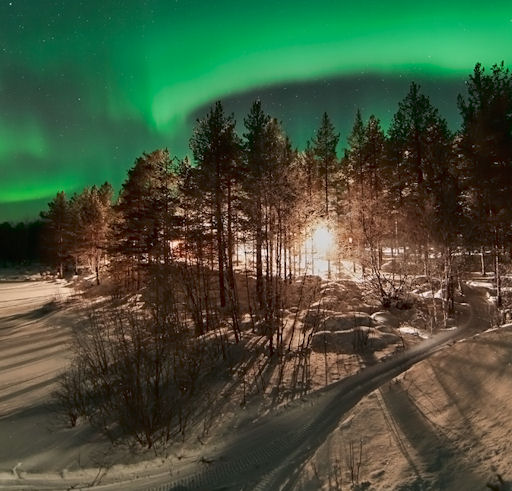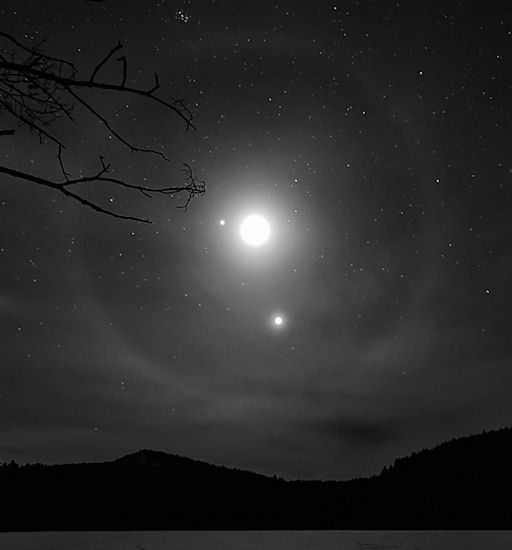CME IMPACT: A CME hit Earth's magnetic field on Feb. 26th at ~2100 UT. Although the impact was weak, it did spark some auroras around the Arctic Circle. "I witnessed a wonderful show here in the municipality of Inari, Finland," reports Andy Keen, who recorded the scene in this 25 second exposure:
The brief outburst, which was visible mainly over Scandinavia, subsided before it became a full-fledged geomagnetic storm.
According to a forecast track prepared by analysts at the Goddard Space Weather Lab, the same CME will hit Mars on Feb. 28th. Because Mars has no global magnetic field to protect it, the impact could rip away a small amount of Mars' atmosphere. Any loss from this one CME would be miniscule, but billions of years of CMEs and solar wind gusts might account for a lot of lost martian air.
If the forecast is correct, the CME could also hit NASA's Mars rover Curiosity later today. Curiosity is en route to the red planet onboard the Mars Science Lab spacecraft. The rover is in no danger from the CME, but it might be able to measure energetic particles accelerated by the CME's passage.
more images: from Thomas Kast of Muonio, Finland; from Thomas Achermann of Utkujärvi, Muonio, Finnish Lapland; from Simon Eskil de Lusua of Östra Näset, Sweden; from Hanneke Luijting of Tromsø, Norway; from Chad Blakley of Abisko National Park, Sweden
February 2012 Aurora Gallery
[previous Februaries: 2011, 2010, 2009, 2008, 2007, 2006, 2004, 2003, 2002]
WEEKEND SKY SHOW: This weekend's triangular conjunction of Venus, Jupiter and the crescent Moon was just as good as advertised. On the beach at Edgecomb Pond in Bolton Landing, New York, amateur astronomer John Cordiale found the bright threesome surrounded by a 22o ice halo:
"I was photographing the alignment when high thin clouds rolled in," says Cordiale. "They threatened to ruin the view, but then this halo encircled Jupiter, Venus and the Moon, framing them perfectly."
As the week unfolds, the Moon will leave Jupiter and Venus behind, but the show isn't over. The two planets are converging for a close encounter on March 12th and 13th--an event so nice it has been described in a NASA news release. Until then, browse the images below.
more images: from Petr Horálek of the Academy of Sciences of the Czech Republic; from Jun Lao of Mason, Ohio; from Marek Nikodem of Szubin, Poland; from Jimmy Westlake of Stagecoach, Colorado; from Zach Brady and John Stetson of Hinckley, Maine; from Todd Bush of Banner Elk, NC; from Pekka Sammallahti of Vetsikko, Utsjoki, Finland; from Brian Emfinger of Ozark, Arkansas; from Gene Taylor of Blue Ridge Parkway, NC; from Charlie Bates Solar Astronomy Project of Atlanta, GA;
Magnetosphere under Pressure~

![]()
Solar wind
speed: 487.2 km/sec
density: 5.8 protons/cm3
explanation | more data
Updated: Today at 1535 UT
![]()
X-ray Solar Flares
6-hr max: B4 0928 UT Feb27
24-hr: B4 0928 UT Feb27
explanation | more data
Updated: Today at: 1500 UT
![]()
![]()
![]()
Daily Sun: 27 Feb 12
![]()
![]()
These sunspots pose no threat for strong flares. Credit: SDO/HMI
![]()
![]()
![]()
Sunspot number: 58
What is the sunspot number?
Updated 26 Feb 2012
Spotless Days
Current Stretch: 0 days
2012 total: 0 days (0%)
2011 total: 2 days (<1%)
2010 total: 51 days (14%)
2009 total: 260 days (71%)
Since 2004: 821 days
Typical Solar Min: 486 days
Updated 26 Feb 2012
The Radio Sun
10.7 cm flux: 107 sfu
explanation | more data
Updated 26 Feb 2012
![]()
![]()
![]()
Current Auroral Oval:
Switch to: Europe, USA, New Zealand, Antarctica
Credit: NOAA/POES
![]()
![]()
![]()
Planetary K-index
Now: Kp= 3 quiet
24-hr max: Kp= 4 unsettled
explanation | more data
![]()
Interplanetary Mag. Field
Btotal: 6.8 nT
Bz: 4.2 nT south
explanation | more data
Updated: Today at 1536 UT
![]()
![]()
![]()
Coronal Holes: 27 Feb 12
![]()
![]()
There are no large coronal holes on the Earthside of the sun. Credit: SDO/AIA.
![]()
![]()
![]() SPACE WEATHER
SPACE WEATHER
NOAA Forecasts

![]()
![]()
Updated at: 2012 Feb 26 2200 UTC
![]()
![]()
![]()
![]()
Geomagnetic Storms:
Probabilities for significant disturbances in Earth's magnetic field are given for three activity levels: active, minor storm, severe storm
![]()
Updated at: 2012 Feb 26 2200 UTC
![]()
Mid-latitudes
![]()
High latitudes






